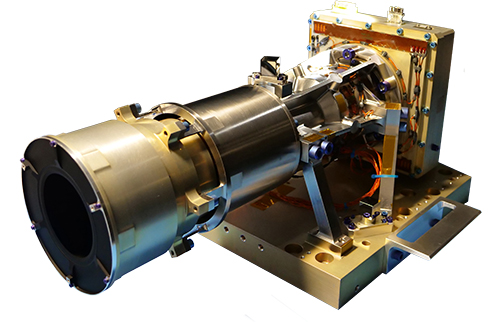We can adapt to your performance requirements, and your weight, dimensions and other constraints to develop a tailor-made solution that is ideal for your needs.
Below you will find a few examples of cameras we have designed for our customers.
Navigation cameras
Our navigation cameras are designed individually to meet your needs.
We work in all orbits, including in highly complex environments (radiation, mechanical and thermal constraints,…).
We are able to achieve extraordinary levels of performance, as some of our products we have produced for major international space agencies can testify. We can also prioritize competitiveness and compact size according to your requirements.
NAVCAM, for the ESA JUICE mission
Sodern has developed and produced the navigation camera for the European JUICE (Jupiter Icy Moons Explorer) mission probe, which is scheduled to launch in 2022. The camera will provide images of the Jupiter moons against a star background in order to optimize the guidance and accuracy control for flyovers within a highly radioactive environment.
With launch scheduled for 2022 with arrival in the Jupiter system in 2029, the probe will spend at least three years making detailed observations of the gas planet, as well as three of its largest moons. Ganymede, Callisto and Europa.
The role of the NavCam will be to provide data to find out the position and speed of the space vehicle in relation to the moon being flown over. It will be used to control the trajectory and optimize fuel consumption during the main circuit of Jupiter. It will also be used to improve the targeting accuracy of the space vehicle, which may then approach within 200 km of the moons.


Narrow Angle Camera, for the ESA Earth Return Orbiter (Mars Sample Return) mission
In 2020, Sodern was selected to develop a high-performance camera to capture a capsule of samples in orbit around Mars, in the context of the joint NASA-ESA Mars Sample Return (MSR) mission.
Sodern will apply its know-how by contributing to the last phase of the mission, named “Earth Return Orbiter” whose purpose will be to capture the capsule in Mars orbit then return in Earth.
To be able to retrieve the capsule of samples at an altitude of 300 – 400 km in orbit around Mars, it will first need to be located by the Narrow Angle Camera (NAC), at a distance between 2000 and 3000km and within the very bright orbit of Mars’s orbit. Sodern will provide this camera.
AURICAM
Auricam is a compact and affordable camera, with a wide-angle lens, which is used to monitor the satellite’s environment and/or to monitor the satellite itself. It is derived from the Auriga star tracker camera, over 700 models of which are already in flight, which guarantees performance and competitiveness. The camera may be connected to software which is able to detect stray objects.
Several fields of vision are responsible depending on customers’ needs.
- CMOS 1 to 4 Mpixel camera
- Compact design
- 35 degree field of vision

Monitor a satellite and its environment
Assessing a satellite
Auricam can be used as a monitoring camera to film the deployment of the different parts of the satellites, the separations, and to assess any anomalies or damage caused; for example, by collisions with micrometeorites. The embedded memory can store dozens of images. Image compression software reduces data transfer requirements. Electronic unit makes it easier to connect and manage multiple cameras.
Rendez-vous sensors
The purpose of the RDV sensor is to make possible a docking with a cooperative or non-cooperative object. It is a system including of Auricam cameras and an electronic unit with an algorithm named ARAMIS. Optionally, an illuminator or infrared cameras can be used.

ARAMIS
« Approach and Rendez-vous Autonomous Multi-mission Integrated Sensor »
Developed by Sodern in partnership with the French Atomic Energy Commission (CEA), ARAMIS is a rendezvous sensor that integrates innovative image processing for all phases of rendezvous missions to both cooperative and non-cooperative satellites, from long-range detection to final approach.
ARAMIS used advanced algorithms for ,on-cooperative approaches, proximity operation and docking.
- Non-cooperative navigation based vision with restitution of 6 degrees of freedom
- Range: long-range detection at final approach
Intruder detectors
Sodern is developing and producing intruder detectors (cameras which are able to detect and observe the approach of a foreign satellite) on behalf of the French Armed Forces Ministry. We also equip the 4A and 4B military telecommunications satellites.
Mapping the debris
Sodern develops and produces cameras to detect and restore space debris trajectory from space.

